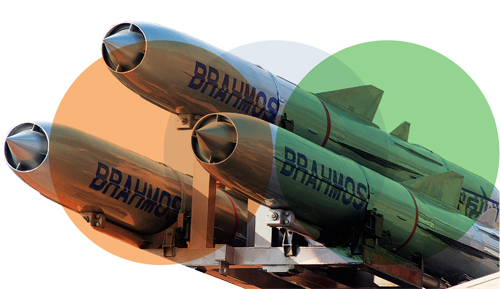INDIAN ARMED FORCES CHIEFS ON
OUR RELENTLESS AND FOCUSED PUBLISHING EFFORTS

SP Guide Publications puts forth a well compiled articulation of issues, pursuits and accomplishments of the Indian Army, over the years

I am confident that SP Guide Publications would continue to inform, inspire and influence.

My compliments to SP Guide Publications for informative and credible reportage on contemporary aerospace issues over the past six decades.
Exports - BrahMos Sets the Pace
For India to build its exports of military hardware, the focus will have to be not just on selling the equipment but also on providing adequate training and support to the customers

As per a written communication dated December 31, 2021 received from the Department of National Defence of the Philippines, the nation has finally decided to purchase the BrahMos supersonic cruise missile system from India. The deal for this shore-based anti-ship missile system is valued at $375 million. The approval for the acquisition of this weapon system from India by the government of the Philippines came several years after the first reports of the nation’s interest in the BrahMos missile became known. With this deal, the Philippines is set to become the first international customer of the highly potent BrahMos supersonic cruise missile. The sale of the BrahMos to the Philippines also marks the entry of India into the supersonic missile domain after Russia that has been a leader in this field. This will also be the first major sale of an advanced weapon system produced by the Indian aerospace and defence industry. Hopefully, this will herald the sale of other weapon systems produced indigenously by the Indian aerospace and defence industry.
With the acquisition of this weapon system, the Philippines has now joined the club of South East Asian nations that possess supersonic anti-ship cruise missiles. Other nations in the club include Indonesia that has operated the ship-based Russian-origin Yakhont supersonic anti-ship cruise missile since 2011 and the Vietnamese Army acquired two land-based Bastion-P mobile coastal defence missile systems from Russia in the year 2015. Acquisition of the BrahMos will significantly enhance the capability of the Philippines to safeguard its sovereign claims in the South China Sea. This weapon system will also serve as a deterrence against incursions by the maritime forces of China into the exclusive economic zone (EEZ) of the Philippines. In recent years, there has been escalation of tension between China and the Philippines with frequent incursion of Chinese naval vessels into the EEZ of the Philippines that extends up to 200 nautical miles from the coastline. In November 2021, Chinese coast guard ships blocked and fired water cannons on supply boats of the Philippines within the country’s EEZ. Earlier, the Philippines had reported an incursion into its EEZ by around 285 vessels of the People’s Liberation Army Navy. In the event of a conflict with China, the Philippines could use the BrahMos to target Chinese vessels in parts of the South China Sea.
Other nations in the region such as Thailand, Vietnam and Indonesia have also evinced interest in acquiring the BrahMos missile system designed, developed and produced by the Indian aerospace and defence industry. Acquisition of the BrahMos with these nations is certainly going to be a matter of concern for China as she may no longer find it easy to pressurise or intimidate them as she has been doing with increasing frequency especially in the recent past.
The BrahMos is the world’s fastest supersonic cruise missile that is designed to fly at nearly three times the speed of sound, making it almost impossible for targets to evade attack by this weapon system. This weapon system has been developed by BrahMos Aerospace which was established on February 12, 1998 as an inter-government joint venture enterprise between the Defence Research and Development Organisation (DRDO) of India and the Federal State Unitary Enterprise NPO Mashinostroyenia (NPOM) of Russia. Based on the Russian P-800 Oniks sea-skimming cruise missile technology, the name BrahMos given to this weapon system is derived from the names of two major rivers namely the Brahmputra (Brah) in India and the Moskava (Mos) in Russia. The BrahMos was first test-fired in a vertical launch configuration on June 12, 2001 from the Integrated Test Range (ITR) at Chandipur in Odisha.
The BrahMos is credited with having set a world record at the integrated test range Launching Complex at Chandipur, Odisha on September 5, 2010, for being the first cruise missile to be tested at supersonic speeds in a steep-dive mode. With this launch, the requirement of the Indian Army for land attack with Block-II advanced seeker software with target discriminating capabilities, was met with. The BrahMos became the only supersonic cruise missile possessing advanced capability of selection of a particular land target amongst a group of targets, providing an edge to the user with its high precision capability. Over the years since the first launch in 2001, several advanced versions of the BrahMos have been developed making it an extremely potent weapon system. India has already deployed a sizable number of the BrahMos missile system in a number of strategic locations along the Line of Actual Control with China in the Ladakh and Arunachal Pradesh sectors.
While the BrahMos is undoubtedly a potent weapon system, in the ultimate analysis, its effectiveness against the enemy in war will depend on how well the manpower maintaining and operating the weapon system is trained. India’s responsibility towards the customer thus will not end with merely marketing of the weapon system, but will extend well beyond.





